
Please Remix this template for your purposes.
- Subject:
- Environmental Literacy and Sustainability
- Material Type:
- Other
- Primary Source
- Author:
- The genius group from Madison Wisconsin
- Date Added:
- 04/06/2024

Please Remix this template for your purposes.

How did photographers help convince Congress to pass child labor laws? We will explore some of Lewis Hine’s photographs that exposed child working conditions and advocated for child labor laws to protect children.
We will investigate the photographer who captured the photos to understand the sourcing of information as part of a historical inquiry.
In this episode, students will engage in careful observation to identify objects and note details (See), generate and test hypotheses based on evidence they have collected (Think), and reflect on their learning by applying it to related questions (Wonder). A key focus is to consider source information and identify aspects of a primary source that reveal a photographer’s point of view or purpose.
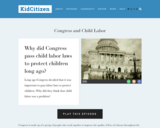
Congress is made up of a group of people who work together to improve the quality of lives of citizens throughout the nation. Long ago Congress decided that it was important to pass labor laws to protect children. Students will answer the question why child labor was a problem? They will explore this question by investigating a series of photographs of children working in fish factories long ago.
In addition,
In this episode, students will engage in careful observation to identify objects and note details (See), generate and test hypotheses based on evidence they have collected (Think), and reflect on their learning by applying it to related questions (Wonder).
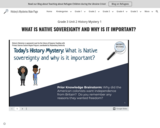
In this lesson, students will learn about some elements of Native sovereignty. They will learn what a Native nation is and why sovereignty is so important to a nation. The lesson focuses on why nations need land, why history is important, and how shared culture is also part of sovereignty. The lesson focuses on Native nations today because it is important to talk about Native nations today to break stereotypes that Native people only existed in the past.
This lesson is part of a Unit that includes the following lessons:
Grade 3 Unit 2 History Mystery 1: WHAT IS NATIVE SOVEREIGNTY AND WHY IS IT IMPORTANT?
Grade 3 Unit 2 History Mystery 2: WHAT CAN DIFFERENT MAPS TELL US ABOUT NATIVE SOVEREIGNTY AND NATIVE LAND?
Grade 3 Unit 2 History Mystery 3: WHAT STRATEGIES TO NATIVE NATIONS USE TO PROTECT THEIR SOVEREIGNTY DURING THE AMERICAN REVOLUTION (1)?
Grade 3 Unit 2 History Mystery 4: WHAT STRATEGIES TO NATIVE NATIONS USE TO PROTECT THEIR SOVEREIGNTY DURING THE AMERICAN REVOLUTION (2)?
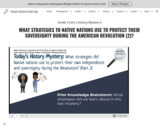
In this mystery, students will look at primary and secondary sources from the four Native nations we have been studying: Haudenosaunee/Iroquois, Cherokee, Chickasaw, and Western Abenaki. They will match their five different strategy cards with the primary and secondary sources. After reading each source, students will determine which strategy that nation used to protect their land and sovereignty during the American Revolution. After each source, students will read a brief summary that will give more information about the strategies used. Student handouts will allow students to mark up the primary and secondary sources, pick a strategy and then explain their reasoning.
This lesson is part of a Unit that includes the following lessons:
Grade 3 Unit 2 History Mystery 1: WHAT IS NATIVE SOVEREIGNTY AND WHY IS IT IMPORTANT?
Grade 3 Unit 2 History Mystery 2: WHAT CAN DIFFERENT MAPS TELL US ABOUT NATIVE SOVEREIGNTY AND NATIVE LAND?
Grade 3 Unit 2 History Mystery 3: WHAT STRATEGIES TO NATIVE NATIONS USE TO PROTECT THEIR SOVEREIGNTY DURING THE AMERICAN REVOLUTION (1)?
Grade 3 Unit 2 History Mystery 4: WHAT STRATEGIES TO NATIVE NATIONS USE TO PROTECT THEIR SOVEREIGNTY DURING THE AMERICAN REVOLUTION (2)?

The lesson begins with a brief introduction to the mystery and then a quick context video to help students understand how and why we have a Bill of Rights. In this lesson, students will explore the importance of free speech in American society by analyzing the words of the 1st Amendment; learning new vocabulary; reading an overview of the history of the 1st amendment; and looking at 4 key reasons why free speech is important in America. For the student activity, students will explore how each of the 4 key reasons for speech relates to their own lives and ideas.
This lesson is part of a Unit that includes the following lessons:
Grade 5 History Mystery 1: WHAT IS "FREE SPEECH" AND WHY DOES IT MATTER?
Grade 5 History Mystery 2: DOES "FREE SPEECH" MEAN I CAN SAY WHATEVER I WANT?
Grade 5 History Mystery 3:WHAT CAN I SAY IN SCHOOL?

In this lesson, students will learn about how the freedom of speech is limited. Students will predict, read about and apply their knowledge of three restrictions on the freedom of speech.
This lesson is part of a Unit that includes the following lessons:
Grade 5 History Mystery 1: WHAT IS "FREE SPEECH" AND WHY DOES IT MATTER?
Grade 5 History Mystery 2: DOES "FREE SPEECH" MEAN I CAN SAY WHATEVER I WANT?
Grade 5 History Mystery 3:WHAT CAN I SAY IN SCHOOL?

: In this lesson, students will learn about how “freedom of speech” is applied in schools. Students will begin by brainstorming the meaning of “free speech” from prior lessons and then brainstorming about how they think speech might be limited in schools. Then students will learn about speech rights in school by completing a reading and watching a short video. For the activity, students will look at school-based scenarios and decide whether or not they think a school could limit student speech.’
This lesson is part of a Unit that includes the following lessons:
Grade 5 History Mystery 1: WHAT IS "FREE SPEECH" AND WHY DOES IT MATTER?
Grade 5 History Mystery 2: DOES "FREE SPEECH" MEAN I CAN SAY WHATEVER I WANT?
Grade 5 History Mystery 3:WHAT CAN I SAY IN SCHOOL?
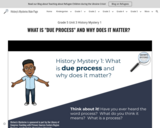
In this mystery, students will learn the meaning of “due process”, where due process rights are in the Constitution, and the history of where American due process rights came from. Students will begin by figuring out the meaning of the term. They will then examine the Bill of Rights and create Due Process Amendment Cards that they will use for this and additional mysteries in this unit. Students will sort the due process rights in the 4th-8th Amendments into the categories before, during and after trial. The will end the mystery by learning about the history of due process including the Magna Carta and due process rights in colonial America.
This lesson is part of a Unit that includes the following lessons:
Grade 5 Unit 3 History Mystery 1: WHAT IS "DUE PROCESS" AND WHY DOES IT MATTER?
Grade 5 Unit 3 History Mystery 2: HOW AND WHY DO PEOPLE FIGHT FOR DUE PROCESS RIGHTS?
Grade 5 Unit 3 History Mystery 3: DO STUDENTS HAVE THE RIGHT TO PRIVACY IN SCHOOL?
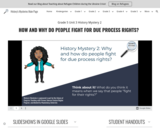
In this mystery, students will learn about three due process champions through the History Mystery questions “Why and how do people fight for due process rights?” The mystery begins by helping students understand what it means to fight for rights and how a person might petition for their rights. Then the mystery takes students through three due process champion stories of John Peter Zenger, Fred Korematsu, and Clarence Gideon. Each story starts with an introduction reading and video. Then students work in groups to investigate a primary source or sources related to each story with the guidance of an investigation packet. Each story helps students answer the history mystery question.
This lesson is part of a Unit that includes the following lessons:
Grade 5 Unit 3 History Mystery 1: WHAT IS "DUE PROCESS" AND WHY DOES IT MATTER?
Grade 5 Unit 3 History Mystery 2: HOW AND WHY DO PEOPLE FIGHT FOR DUE PROCESS RIGHTS?
Grade 5 Unit 3 History Mystery 3: DO STUDENTS HAVE THE RIGHT TO PRIVACY IN SCHOOL?
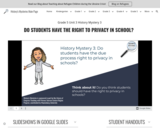
In this mystery, students will learn about what due process rights young people have in and out of school. They will start by learning some background information and then specifically learn about the Reasonable Suspicion Standard for conducting student searches in schools. Students will then have two activities to practice applying the standard. The lesson will culminate with students analyzing real court cases and using their knowledge to apply the Reasonable Suspicion Standard.
This lesson is part of a Unit that includes the following lessons:
Grade 5 Unit 3 History Mystery 1: WHAT IS "DUE PROCESS" AND WHY DOES IT MATTER?
Grade 5 Unit 3 History Mystery 2: HOW AND WHY DO PEOPLE FIGHT FOR DUE PROCESS RIGHTS?
Grade 5 Unit 3 History Mystery 3: DO STUDENTS HAVE THE RIGHT TO PRIVACY IN SCHOOL?
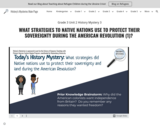
In this lesson, students will be introduced to five different strategies that Native nations used to protect their land and sovereignty during the American Revolution. Students will be reminded about the key ideas of the American Revolution and learn a little bit about how the Americans talked about Native people in the Declaration of Independence. They will also learn that both the British and the Americans tried to court Native nations to join their side during the war. Students will then be introduced to five different strategies used by different Native nations.
This lesson is part of a unit that includes the following lessons:
Grade 3 Unit 2 History Mystery 1: WHAT IS NATIVE SOVEREIGNTY AND WHY IS IT IMPORTANT?
Grade 3 Unit 2 History Mystery 2: WHAT CAN DIFFERENT MAPS TELL US ABOUT NATIVE SOVEREIGNTY AND NATIVE LAND?
Grade 3 Unit 2 History Mystery 3: WHAT STRATEGIES TO NATIVE NATIONS USE TO PROTECT THEIR SOVEREIGNTY DURING THE AMERICAN REVOLUTION (1)?
Grade 3 Unit 2 History Mystery 4: WHAT STRATEGIES TO NATIVE NATIONS USE TO PROTECT THEIR SOVEREIGNTY DURING THE AMERICAN REVOLUTION (2)?
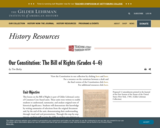
This lesson on the Bill of Rights is part of Gilder Lehrman’s series of Common Core-based units. These units were written to enable students to understand, summarize, and analyze original texts of historical significance. Students will demonstrate this knowledge by writing summaries of selections from the original document and, by the end of the unit, demonstrating their understanding through visual and oral presentations. Through this step-by-step process, students will acquire the skills to analyze any primary or secondary source material.
Lesson #1
Students will understand the rights and restrictions that are defined by the first five amendments of the Bill of Rights in the United States Constitution. They will demonstrate that understanding by restating those ideals in their own words.
Lesson #2
Students will understand the rights and restrictions that are defined by amendments 6–10 of the Bill of Rights in the United States Constitution. They will demonstrate that understanding by restating those ideals in their own words.
Lesson #3
Students will demonstrate their understanding of the Bill of Rights by drawing an illustration depicting one of the amendments and citing a direct quote from the amendment as a caption. This caption will serve as direct evidence for the accurate interpretation of the text. The students will then present their drawing in the form of a short oral presentation to the class. The teacher may allow students to substitute a computer-based drawing or graphics alternative to an actual hand-drawn illustration.

This unit is part of Gilder Lehrman’s series of Common Core State Standards–based teaching resources. These units were developed to enable students to understand, summarize, and analyze original texts of historical significance. Through a step-by-step process, students will acquire the skills to analyze any primary or secondary source material.
Over the course of three lessons the students will analyze text from three documents defining American democracy: the Preamble to the United States Constitution, the Pledge of Allegiance, and the second section of the Declaration of Independence. Understanding these three texts is an essential part of understanding American ideology and citizenship. Students will closely analyze these sources and use textual evidence to draw their conclusions and present their understanding as directed in each lesson.
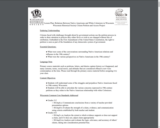
In this lesson, students will understand some of the struggles and prejudices Native Americans faced
in 19th-century Wisconsin. They will also be able to articulate the various concerns expressed in 19th-century
petitions as they relate to the Native American relationship with white Colonizers.
Note: Primary source materials such as petitions, letters, and diaries capture history as it happened, and
many customs, terms, social mores, and attitudes that are considered offensive now were
commonplace at the time. Please read through the primary source material before assigning it to
your class.
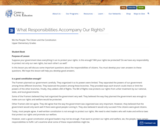
We the People: The Citizen and the Constitution
In this lesson you will discuss some important questions about the responsibilities of citizens. You must develop your own answers to these questions. We hope this lesson will help you develop good answers.